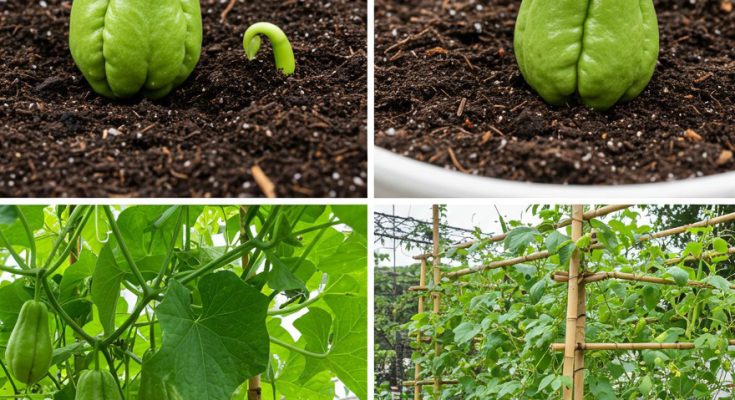Chayote (Sechium edule), also known as vegetable pear or mirliton, is a fast-growing, productive vine that produces abundant fruits with minimal care and investment. Whether you’re working with a small backyard or a modest terrace, growing chayote at home is not only easy but also incredibly cost-effective.
This article shares a step-by-step guide to growing chayote using simple, budget-friendly techniques. With just one sprouted fruit and some basic materials, you can enjoy a lush vine that yields plenty of fresh, nutritious produce.
Why Grow Chayote?
Chayote is a versatile vegetable rich in fiber, vitamins, and antioxidants. It’s used in soups, stir-fries, salads, and can even be eaten raw. The plant itself is vigorous and hardy, thriving in a variety of climates with minimal input.
Benefits of growing chayote at home:
-
-
Low maintenance and fast-growing
-
-
-
High-yielding over a long season
-
Grows vertically, saving space
-
Few pest and disease issues
-
-
Requires little fertilizer or watering once established
Getting Started: What You Need
To grow chayote, you don’t need seeds—just one mature fruit.
Materials:
-
-
1 mature chayote fruit (slightly wrinkled and starting to sprout)
-
-
-
A large container or open ground space
-
Organic compost or manure
-
A strong support structure (trellis, fence, or bamboo poles)
-
Tip: Choose a chayote that is firm but starting to sprout at the narrow end. If it hasn’t sprouted yet, place it in a warm, shaded area for a week or two until a shoot appears.
Planting the Chayote
Once sprouted, the fruit itself is planted whole. Here’s how:
-
-
Choose a sunny location with at least 6–8 hours of light daily.
-
Prepare the soil by loosening it deeply and mixing in compost or well-rotted manure.
-
-
Plant the whole fruit at a 45-degree angle, half-buried in the soil with the sprouted end facing upward. Keep the sprout above ground.
-
Water thoroughly after planting, but avoid waterlogging.
If using a container, choose one that is at least 18–20 inches deep and wide, as chayote develops an extensive root system.
Building a Low-Cost Support Structure
Chayote vines can grow rapidly, often exceeding 20 feet. A strong trellis or support system is essential.
You can build a simple structure using:
-
-
Bamboo poles or wooden stakes
-
-
Nylon netting or garden twine
-
An overhead arch or vertical wall structure
The goal is to train the vines upward, which keeps the plant healthy and makes harvesting easier.
Watering and Fertilizing
Chayote enjoys moist soil, especially during early growth and fruiting. Follow these watering guidelines:
-
Water 2–3 times a week, increasing during hot or dry periods.
-
Mulch with dry leaves, straw, or grass clippings to retain moisture and suppress weeds.
Fertilizer needs are minimal:
-
-
Apply compost or organic fertilizer once a month during the growing season.
-
Supplement with banana peel tea or wood ash for potassium to support flowering and fruiting.
-
Avoid excessive nitrogen, which can lead to more leaves but fewer fruits.
Training and Pruning for Better Yield
To get more fruit and less vine, gentle pruning and training help:
-
-
Pinch off the tips of the main vine once it reaches the top of the support to encourage side shoots.
-
Remove excess foliage or tangled vines to improve airflow and sunlight penetration.
-
-
Train side branches evenly across the support to maximize flowering sites.
This focused growth boosts fruit production without the plant becoming unmanageable.
Pollination Tips
Chayote has both male and female flowers on the same plant. Bees and insects usually handle pollination, but if you’re growing in an enclosed area, hand-pollination helps.
To hand-pollinate:
-
-
Identify male flowers (thin stem, no swelling) and female flowers (with small fruit at the base).
-
Use a soft brush or cotton swab to transfer pollen from the male flower to the center of the female flower.
-
This ensures more successful fruit set, especially in low-insect environments.
Harvesting Chayote
Chayote is typically ready to harvest 90–120 days after planting. Harvest when the fruit is still light green and tender.
-
-
Cut the fruit carefully with scissors or pruning shears, leaving a small portion of the stem attached.
-
Frequent harvesting encourages the plant to produce more fruit.
-
Each plant can produce dozens of fruits per season, and in warm climates, it can continue producing for months.
Propagating for Future Crops
You don’t need to buy seeds again. Simply save a few healthy fruits and let them sprout for the next planting season.
Chayote is a perennial in warm climates and can regrow from the same rootstock for several years if protected from frost.
Conclusion: Grow More for Less
Growing chayote is an ideal way to produce large amounts of fresh, healthy food at very low cost. All it takes is one sprouting fruit, basic soil preparation, and a homemade trellis. With minimal effort and materials, you can enjoy a lush vine and a season full of versatile, tasty produce.
This method is perfect for beginners, families, and anyone interested in homegrown vegetables without the need for expensive equipment or complicated techniques.
